You’re working with delicate wires, open flames, and potentially hazardous chemicals when you create filigree jewelry. While the artistry captivates you, one moment of carelessness can lead to serious injury or workspace damage. Professional jewelers know that safety protocols aren’t just suggestions—they’re essential practices that protect both your well-being and your craft. Understanding these ten critical safety measures will transform how you approach every aspect of your filigree work.
Essential Personal Protective Equipment for Filigree Work
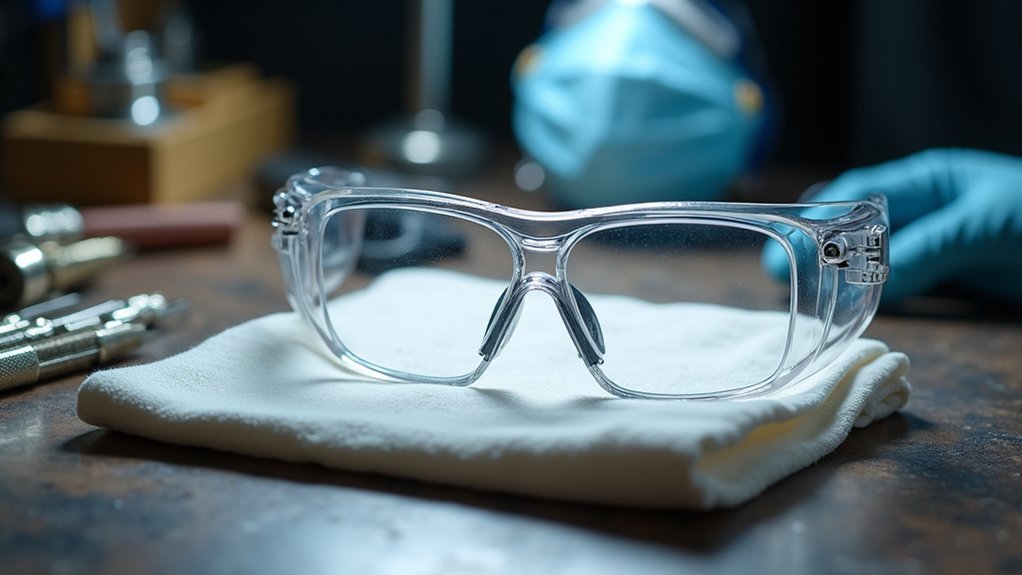
When crafting delicate filigree jewelry, you’ll need proper protective equipment to safeguard yourself from the various hazards inherent in this intricate metalworking process.
Safety glasses or goggles with side shields are essential for protecting your eyes from flying debris and sharp metal fragments. You’ll want nitrile or latex gloves when handling chemicals to prevent skin irritation and burns. A durable apron shields your clothing and skin from sharp tools and chemical spills.
Essential protective gear includes safety glasses with side shields, chemical-resistant gloves, and a durable apron to prevent injuries during metalworking.
Personal protective equipment also includes a dust mask or respirator during sanding and polishing to avoid inhaling fine particles.
These safety precautions extend beyond gear—keep hair tied back and remove loose jewelry to prevent entanglement with tools while creating your intricate designs.
Workspace Ventilation and Air Quality Management
You’ll need to establish proper air circulation in your workspace to protect yourself from harmful fumes and airborne particles created during filigree work.
Start by opening windows and installing exhaust fans to create consistent airflow that carries contaminated air away from your breathing zone.
For processes involving soldering or chemical treatments, you’ll want to implement targeted fume extraction systems that capture toxic vapors at their source before they can spread throughout your workspace.
Proper Air Circulation Setup
Although many jewelry makers focus primarily on tool safety, establishing proper air circulation ranks equally important for protecting your health during filigree work.
You’ll need adequate ventilation to prevent harmful fumes and dust accumulation that can damage your respiratory system over time. Position your workbench strategically away from direct drafts while maintaining sufficient airflow around your workspace.
Essential air circulation components include:
- Your breathing matters – Install HEPA-filtered air purifiers to capture dangerous microscopic particles that threaten your lungs.
- Your workspace deserves protection – Open windows and activate exhaust fans to maintain ideal air quality throughout your crafting sessions.
- Your health requires vigilance – Monitor air conditions regularly, especially when using adhesives or chemical treatments that release toxic vapors.
Chemical Fume Control
Chemical fumes from soldering, patina solutions, and metal cleaners pose serious health risks that require immediate attention through strategic workspace ventilation.
You’ll need adequate fume hoods or exhaust fans to effectively eliminate harmful vapors during filigree work. Open windows and doors regularly to maintain fresh air circulation and reduce airborne contaminant concentration.
Install air quality monitors to track volatile organic compounds and guarantee they stay within safe limits.
Establish routine maintenance schedules for your ventilation equipment to maximize fume removal efficiency.
For chemical fume control during particularly hazardous processes, wear N95 masks or respirators as additional protection.
These appropriate safety measures create multiple layers of defense against toxic inhalation while maintaining ideal working conditions for intricate filigree techniques.
Proper Handling and Storage of Fine Wire Materials
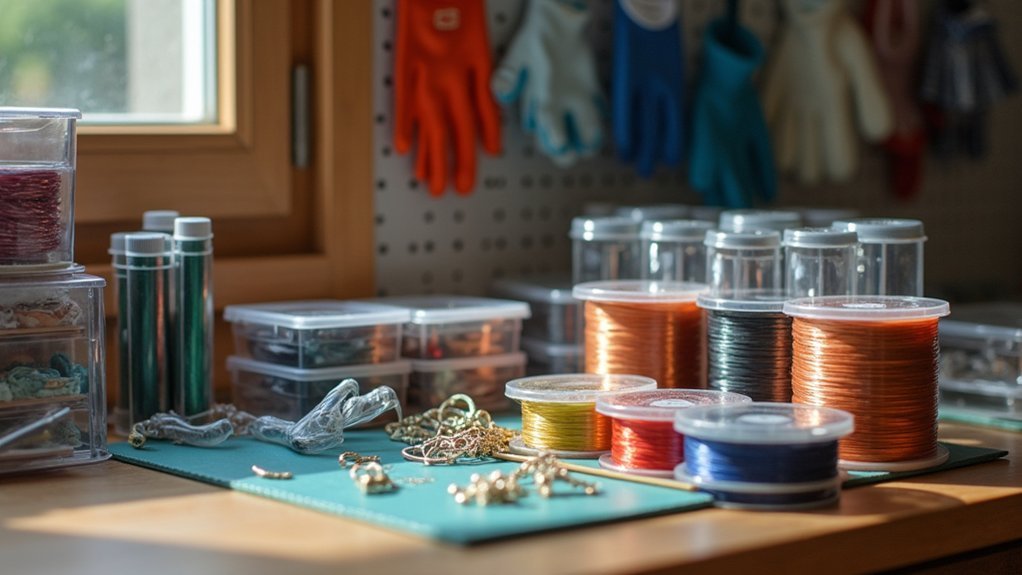
Since fine wire materials form the foundation of quality filigree work, you must establish proper handling and storage practices from the moment you bring them into your workspace.
These safety tips protect your investment and guarantee consistent results in your jewelry making endeavors.
Store your wire in dedicated, dry containers with labeled compartments to prevent oxidation and tangling.
This organization system keeps materials accessible while maintaining their pristine condition.
Essential Wire Safety Practices:
- Use only non-metallic tools and materials – Nylon pliers prevent surface scratches that compromise wire integrity.
- Handle with gentle precision – Excessive force creates devastating kinks and breaks that ruin delicate work.
- Inspect regularly for damage – Corroded wire destroys hours of meticulous craftsmanship.
Replace compromised materials immediately to maintain professional-quality results.
Torch Safety and Heat Management Protocols
When you’re working with a torch in jewelry making, you’ll need to establish proper setup procedures that prioritize safety over speed.
You must master heat control techniques to prevent overheating your materials and avoid accidents that can result from excessive flame exposure.
Additionally, you’ll want to implement effective cooling safety procedures to handle hot metals properly and protect yourself from burns during the quenching process.
Proper Torch Setup
Before you ignite your torch for filigree work, you’ll need to establish a safe workspace that protects both you and your surroundings.
Position your torch on a stable, heat-resistant surface away from any flammable materials that could spark an accidental fire.
Always wear safety glasses and heat-resistant gloves as essential safety equipment to shield yourself from heat exposure and flying debris.
Your torch setup requires these critical steps:
- Secure your fuel connection – Check for gas leaks before igniting to prevent dangerous explosions that could devastate your workspace.
- Prepare your quenching station – Keep a water-filled bowl nearby to immediately cool heated metals and prevent painful burns.
- Master flame control – Start with low flames and gradually increase intensity to maintain precise control over delicate filigree components.
Heat Control Techniques
How precisely can you control the intense heat radiating from your torch to achieve flawless filigree results without compromising safety?
Master heat control by implementing timer switches to monitor heating duration and prevent overheating your delicate silver wires. Keep your torch moving in controlled patterns rather than concentrating heat in one spot, which can cause warping or melting.
Wear appropriate safety gear including heat-resistant gloves and safety glasses to protect against radiant heat exposure. Position a water bowl within arm’s reach for immediate quenching of hot metal after soldering.
Use your heatproof soldering mat to contain heat and protect your work surface. Maintain proper ventilation to disperse toxic fumes and regulate ambient temperature while working.
Cooling Safety Procedures
After completing your soldering work, you’ll need to implement systematic cooling procedures that protect both you and your workspace from residual heat dangers.
Your safety depends on following proper protocols when handling heated metals and tools during filigree jewelry creation.
Essential cooling safety measures for your work include:
- Quench heated metals immediately – Drop hot silver wires into your water bowl to prevent severe burns that could end your jewelry-making dreams forever.
- Wait for complete tool cooling – Never touch torches or soldering tools until they’re completely cool, avoiding painful injuries that could sideline your craft.
- Maintain workspace ventilation – Keep air flowing to dissipate toxic fumes and excess heat that threaten your health.
These systematic approaches guarantee you’ll continue creating beautiful filigree pieces safely.
Chemical Safety When Using Flux and Cleaning Solutions
When working with flux and cleaning solutions in jewelry making, you’ll encounter chemicals that can pose serious health risks if handled improperly. Chemical safety starts with proper protective equipment—always wear chemical-resistant gloves and safety goggles to prevent skin irritation and eye injuries from splashes or fumes.
| Safety Measure | Implementation |
|---|---|
| Ventilation | Open windows or use exhaust fans |
| Mixing Protocol | Use non-metal utensils, add flux to water |
| Storage | Sealed containers away from heat/sunlight |
| Documentation | Review MSDS for hazards and first aid |
Ensure adequate ventilation in your workspace to minimize inhalation of harmful vapors. When mixing solutions, always add flux to water rather than the reverse to prevent dangerous reactions. Store all chemicals in clearly labeled containers away from heat sources, and familiarize yourself with Material Safety Data Sheets for proper emergency procedures.
Tool Maintenance and Sharp Instrument Safety
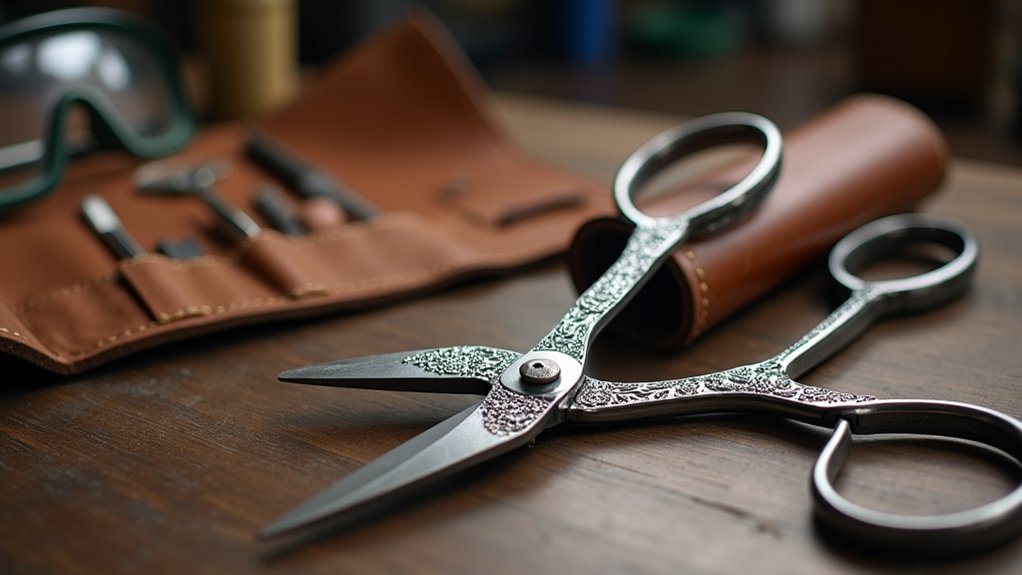
Sharp tools form the backbone of precision jewelry work, but they’re also your greatest safety hazard if not properly maintained.
Proper tool maintenance and sharp instrument safety protocols protect you from serious injuries while ensuring peak performance during delicate filigree work.
Well-maintained sharp tools are essential for both safety and precision in delicate jewelry crafting work.
Regular inspection prevents accidents before they happen. Check your tools for chipped blades, loose handles, or any signs of wear that could compromise safety.
Keep cutting instruments razor-sharp—dull tools slip unexpectedly and cause more injuries than properly maintained ones.
Essential Safety Practices:
- Store sharp instruments in designated tool rolls or secure drawers to prevent accidental contact that could slice your fingers.
- Wear cut-resistant gloves during intricate work to shield your hands from punctures and cuts.
- Clean and oil tools after each session to prevent rust and maintain smooth operation.
Electrical Safety for Soldering Equipment
While sharp tools pose physical dangers, electrical hazards from soldering equipment can prove equally devastating if you don’t follow proper safety protocols. Always plug your soldering iron into a grounded outlet to prevent electrical shocks. Choose equipment with safety switches or automatic shut-off features to reduce overheating and fire risks.
Inspect your soldering tools regularly for frayed cords, damaged plugs, or wear signs that could cause electrical malfunctions. Keep your work area clean by removing flammable materials and eliminating clutter that increases fire hazards.
Use a heatproof mat under your soldering station and guarantee proper ventilation to manage heat buildup and toxic soldering fumes. These electrical safety measures protect both you and your workshop from potentially catastrophic accidents.
Emergency Response Procedures for Workshop Accidents
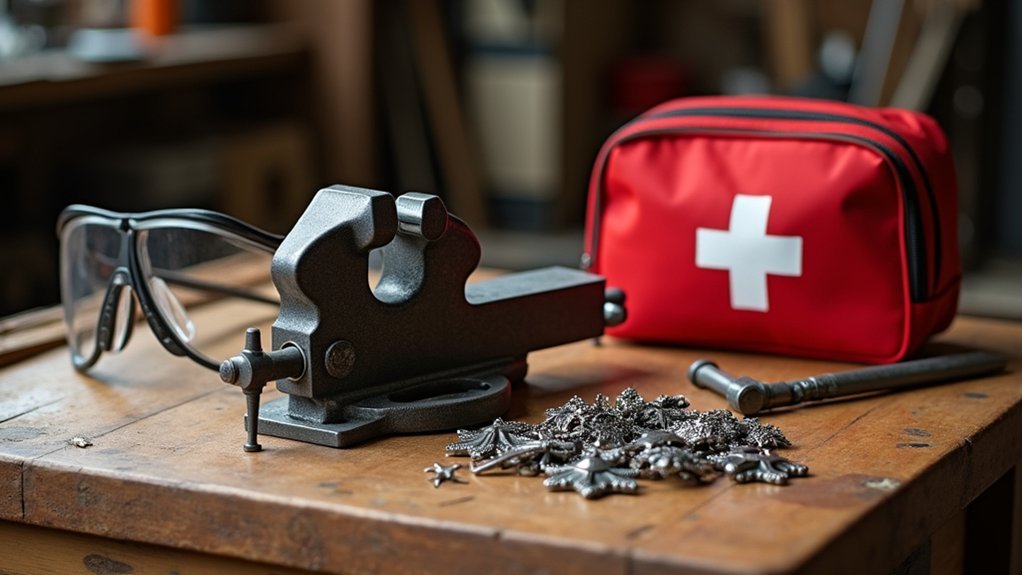
Accidents happen fast in jewelry workshops, so you’ll need quick, decisive action to minimize harm and prevent further injury.
Your emergency response plan starts with ensuring your own safety before helping others. Know where first aid kits and fire extinguishers are located for immediate access. Health and safety protocols require you to follow MSDS guidelines for chemical spills while wearing protective gear.
Safety first means protecting yourself before assisting others – locate emergency equipment and follow proper protocols immediately.
Critical Emergency Response Steps:
- Eye injuries demand immediate action – flush with clean water for 15 minutes minimum to prevent permanent damage.
- Chemical spills can poison you – contain quickly using proper protective equipment to avoid exposure.
- Unreported accidents endanger everyone – notify your instructor immediately to protect future workshop users.
Document everything for continuous safety improvement.
Eye Protection During Microscopic Detail Work
How many jewelry makers realize that their eyes face constant danger during detailed filigree work?
You’re working with razor-sharp wires that can snap and send debris flying directly toward your face. Standard prescription glasses won’t cut it—you need safety glasses or goggles with side shields for basic protection during cutting and shaping.
For soldering and polishing tasks, upgrade to full-seal goggles.
These activities produce harmful fumes and splashes that regular eyewear can’t block. Consider full face protection for intensive sessions involving multiple hazardous processes.
Combine magnifying lenses with your eye protection to enhance visibility while maintaining safety.
This reduces errors that could create dangerous situations. Inspect your protective gear regularly, checking for scratches or damage that compromise visibility and protection effectiveness.
Safe Disposal of Hazardous Materials and Metal Scraps
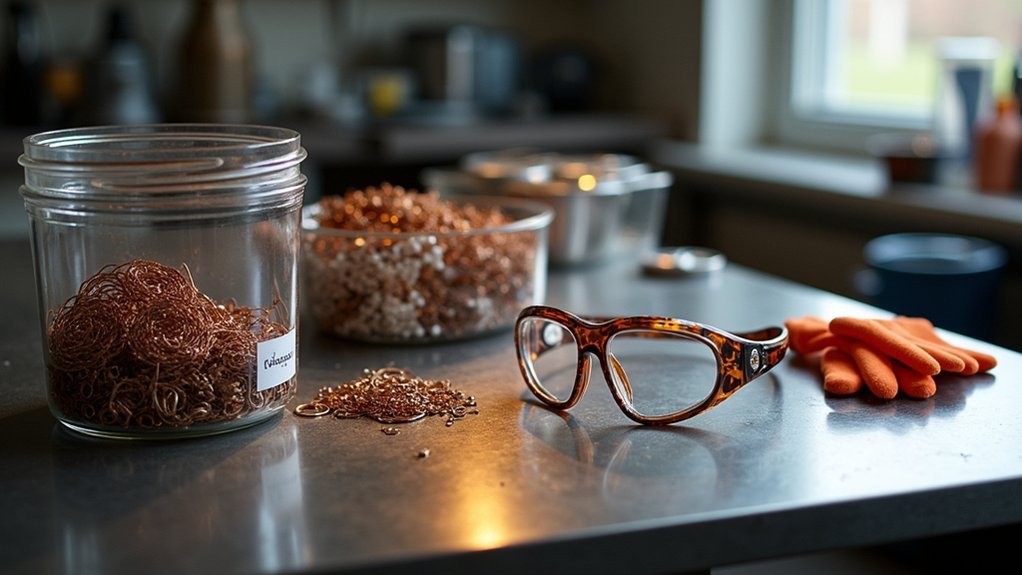
You’ll need to establish proper chemical disposal methods to handle the toxic substances used in pickling solutions and polishing compounds.
Metal scraps from your filigree work shouldn’t end up in regular trash—they’re valuable materials that can be recycled through scrap metal dealers.
Following environmental protection practices isn’t just about compliance; it’s about safeguarding your workspace and the broader community from contamination.
Chemical Disposal Methods
When working with chemicals and metals in jewelry making, proper disposal becomes as essential as the crafting process itself.
Your chemical disposal methods directly impact environmental safety and protect others from potential hazards. You’ll need to consult local regulations since disposal guidelines vary by region and chemical type.
Here’s how you can responsibly dispose of jewelry-making chemicals:
- Never pour chemicals down drains – You’re literally poisoning waterways and endangering aquatic life with every drop.
- Use designated hazardous waste containers – You’re protecting your family and community from toxic exposure.
- Study Material Safety Data Sheets – You’re becoming the safety hero your workspace desperately needs.
Always make sure chemical containers are completely empty and properly labeled before taking them to disposal sites.
Metal Scrap Recycling
Every piece of metal you trim, file, or cut during jewelry making represents valuable material that shouldn’t end up in your regular trash. Set up a dedicated recycling container specifically for metal scraps to prevent contamination and guarantee proper disposal.
You’ll want to use a designated bucket with clear labeling to distinguish between recyclable materials and hazardous waste.
Research local recycling facilities that accept metal scraps, particularly those offering specialized services for precious metals like silver and gold. These facilities often provide financial returns, making your recycling efforts profitable.
Remember to dispose of any chemicals used in your jewelry-making process according to local regulations to avoid environmental harm. Regularly review safety guidelines for hazardous material disposal to minimize chemical exposure risks.
Environmental Protection Practices
While proper metal recycling forms the foundation of responsible jewelry making, environmental protection extends far beyond salvaging precious scraps to encompass the safe handling of all hazardous materials in your workspace.
You must store chemicals and acids in clearly labeled containers and dispose of them through local hazardous waste disposal centers. Never pour toxic substances down the drain, as this threatens aquatic life and water resources.
Your commitment to preventing environmental contamination includes:
- Protecting innocent wildlife from chemical poisoning by following proper disposal methods
- Safeguarding children and pets by securely capping and storing hazardous materials away from living areas
- Preserving clean water for future generations by avoiding drain disposal
Regularly maintain your workspace to guarantee all hazardous materials remain properly contained and secure.
Frequently Asked Questions
What PPE Is Required for Jewelry Making?
You’ll need safety glasses, nitrile gloves, heat-resistant gloves, a durable apron, and dust masks. These protect you from flying debris, chemicals, burns, and harmful particulates during soldering, polishing, and grinding operations.
What Are the Hazards of Jewelry Making?
You’ll face cuts from sharp tools, burns from soldering equipment, repetitive strain injuries from prolonged work, eye damage from flying debris, and chemical splashes during etching processes that can cause serious harm.
How Do You Make Safety Pins for Jewelry?
You’ll cut 20-24 gauge wire to length, form a tight loop with round-nose pliers, bend into U-shape, then create a hook clasp by bending the wire back toward the pin for secure closure.
What Is the Best Metal to Practice Jewelry?
You’ll want to start with copper since it’s affordable and malleable, making mistakes less costly. Brass is another great option that mimics gold’s appearance while remaining budget-friendly for learning fundamental techniques.
In Summary
You’ll master filigree jewelry making safely by following these ten protocols consistently. Don’t compromise on protective equipment or workspace ventilation—they’re your first line of defense. Keep your tools maintained, chemicals properly stored, and emergency procedures fresh in your mind. Remember, you’re working with delicate materials and potentially dangerous equipment. Stay vigilant, practice these safety measures religiously, and you’ll create beautiful filigree pieces while protecting yourself from preventable accidents.

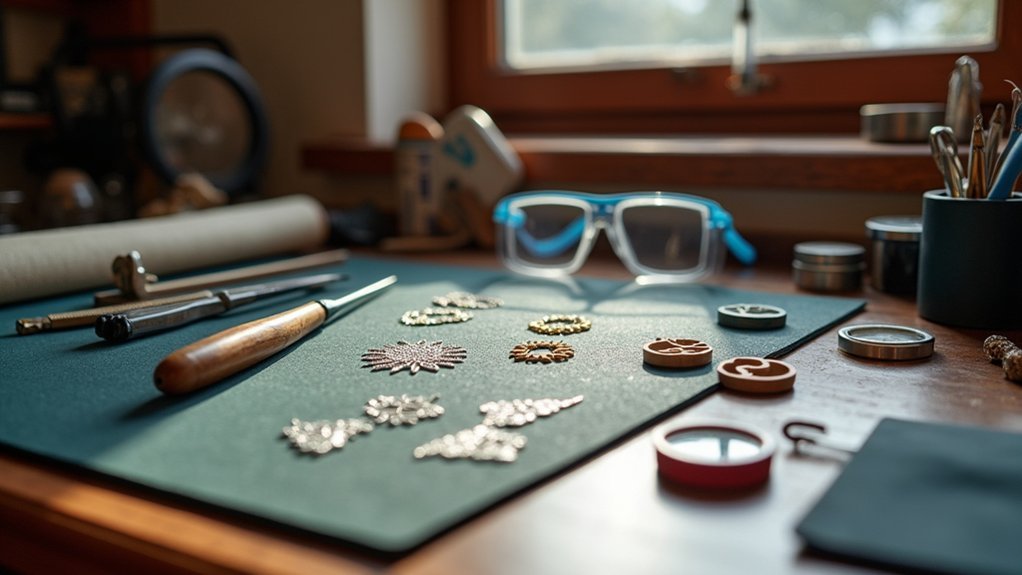
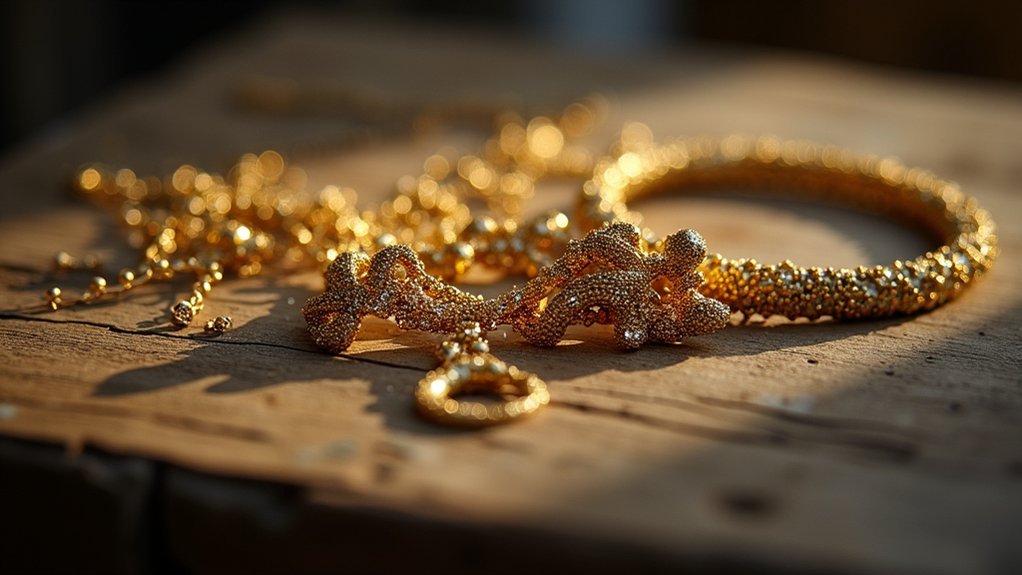
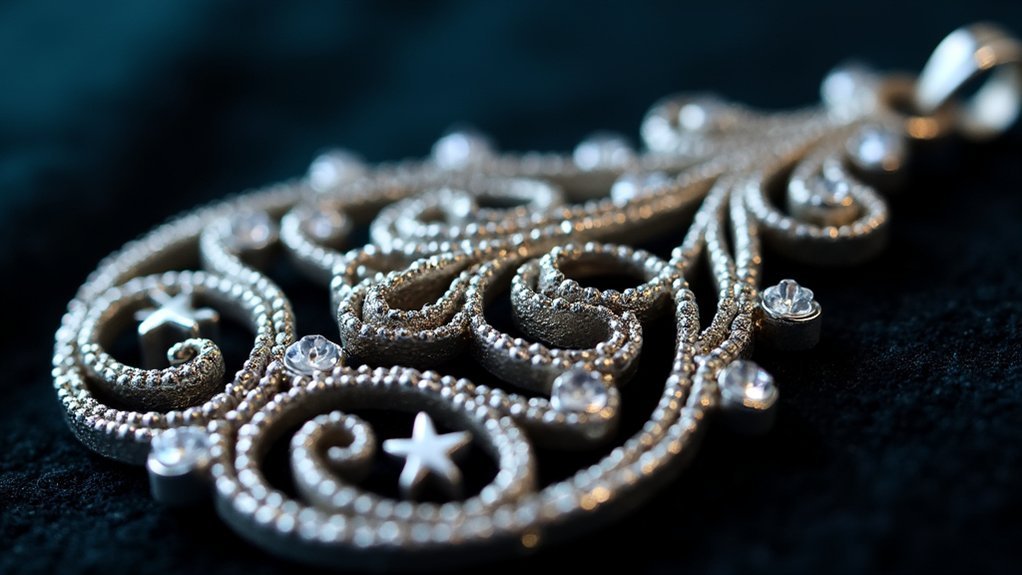
Leave a Reply